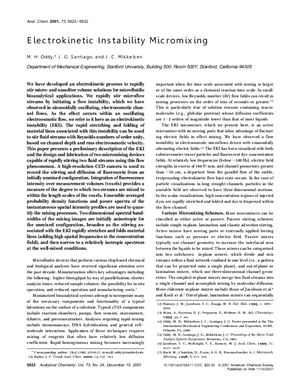Anal. Chem. 2001, 73, 5822-5832
We have developed an electrokinetic process to rapidly stir micro- and nanoliter volume solutions for microfluidic bioanalytical applications. We rapidly stir microflow streams by initiating a flow instability, which we have observed in sinusoidally oscillating, electroosmotic channel flows. As the effect occurs within an oscillating electroosmotic flow, we refer to it here as an electrokinetic instability (EKI). The rapid stretching and folding of material lines associated with this instability can be used to stir fluid streams with Reynolds numbers of order unity,
based on channel depth and rms electroosmotic velocity. This paper presents a preliminary description of the EKI and the design and fabrication of two micromixing devices capable of rapidly stirring two fluid streams using this flow phenomenon. A high-resolution CCD camera is used to record the stirring and diffusion of fluorescein from an initially unmixed configuration. Integration of fluorescence intensity over measurement volumes (voxels) provides a
measure of the degree to which two streams are mixed to within the length scales of the voxels. Ensemble-averaged probability density functions and power spectra of the
instantaneous spatial intensity profiles are used to quantify the mixing processes.
We have developed an electrokinetic process to rapidly stir micro- and nanoliter volume solutions for microfluidic bioanalytical applications. We rapidly stir microflow streams by initiating a flow instability, which we have observed in sinusoidally oscillating, electroosmotic channel flows. As the effect occurs within an oscillating electroosmotic flow, we refer to it here as an electrokinetic instability (EKI). The rapid stretching and folding of material lines associated with this instability can be used to stir fluid streams with Reynolds numbers of order unity,
based on channel depth and rms electroosmotic velocity. This paper presents a preliminary description of the EKI and the design and fabrication of two micromixing devices capable of rapidly stirring two fluid streams using this flow phenomenon. A high-resolution CCD camera is used to record the stirring and diffusion of fluorescein from an initially unmixed configuration. Integration of fluorescence intensity over measurement volumes (voxels) provides a
measure of the degree to which two streams are mixed to within the length scales of the voxels. Ensemble-averaged probability density functions and power spectra of the
instantaneous spatial intensity profiles are used to quantify the mixing processes.

